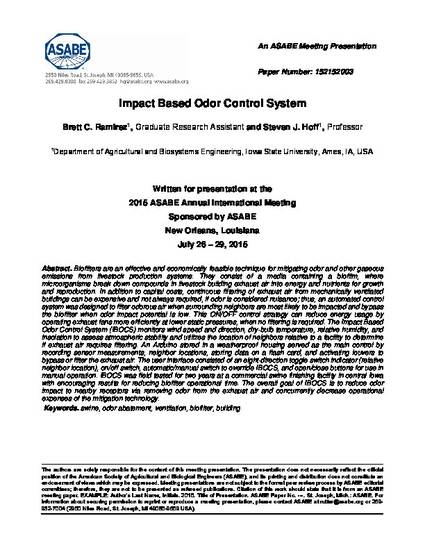
Biofilters are an effective and economically feasible technique for mitigating odor and other gaseous emissions from livestock production systems. They consist of a media containing a biofilm, where microorganisms break down compounds in livestock building exhaust air into energy and nutrients for growth and reproduction. In addition to capital costs, continuous filtering of exhaust air from mechanically ventilated buildings can be expensive and not always required, if odor is considered nuisance; thus, an automated control system was designed to filter odorous air when surrounding neighbors are most likely to be impacted and bypass the biofilter when odor impact potential is low. This ON/OFF control strategy can reduce energy usage by operating exhaust fans more efficiently at lower static pressures, when no filtering is required. The Impact Based Odor Control System (IBOCS) monitors wind speed and direction, dry-bulb temperature, relative humidity, and insolation to assess atmospheric stability and utilizes the location of neighbors relative to a facility to determine if exhaust air requires filtering. An Arduino stored in a weatherproof housing served as the main control by recording sensor measurements, neighbor locations, storing data on a flash card, and activating louvers to bypass or filter the exhaust air. The user interface consisted of an eight-direction toggle switch indicator (relative neighbor location), on/off switch, automatic/manual switch to override IBOCS, and open/close buttons for use in manual operation. IBOCS was field tested for two years at a commercial swine finishing facility in central Iowa with encouraging results for reducing biofilter operational time. The overall goal of IBOCS is to reduce odor impact to nearby receptors via removing odor from the exhaust air and concurrently decrease operational expenses of the mitigation technology.
Available at: http://works.bepress.com/steven_hoff/117/

This proceeding is from the 2015 ASABE Annual International Meeting, Paper No. 152152003, pages 1-9 (doi:10.13031/aim.20152152003). St. Joseph, Mich.: ASABE.